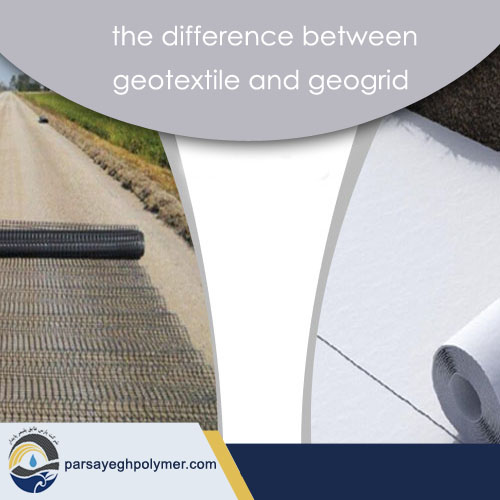the difference between geotextile and geogrid

Geotextile and geogrid are two types of geosynthetic materials commonly used in civil engineering and construction. They serve distinct purposes and have different properties, applications, and functionalities. Here’s a detailed comparison of the two:
geotextile and geogrid in terms of definition
What are geotextiles ?
Geotextiles are defined as any permeable textile used for dirt, soil, earth, or rock in any geotechnical engineering-related project or structure or system. They are the most widely-used geosynthetic for agriculture. There are both woven and non-woven geotextiles.(2)
Geotextiles are permeable fabrics made from synthetic fibers (such as polypropylene or polyester). They come in woven or non-woven forms.
Types of geotextile:
- Woven Geotextiles: Made by weaving threads together in a regular pattern.
- Non-woven Geotextiles: Made by bonding fibers together using heat, chemicals, or needle punching.
What is a geogrid ?
Geogrids are materials designed with a grid-like structure, made from polymers such as polypropylene, polyethylene, or polyester.
These are open mesh-like materials of integrally connected polymers. Geogrids are made from polyester, polyethylene, or polypropylene. They are used for soil or hardscape reinforcement and stabilisation; for instance, reinforcing a retaining wall backfill.
Comparison of geotextile and geogrid In terms of function
Functions of geotextile:
- Separation: Prevents mixing of different soil layers.
- Filtration: Allows water to pass through while retaining soil particles.
- Drainage: Facilitates the movement of water along the plane of the fabric.
- Reinforcement: Provides added strength to support loads.
- Protection: Shields geomembranes from puncture and damage.
Functions of geogrid
- Reinforcement: Provides tensile strength to support and stabilize soil structures. It improves the load-bearing capacity of soils by distributing loads over a larger area.
- Confinement: Restrains soil particles within its apertures, reducing lateral movement and increasing stability.
Bearing Capacity Improvement: Enhances the bearing capacity of soil by creating a stable platform.
Comparison of geotextile and geogrid In terms of applications
applications of Geotextile:
- Road Construction: Used as a separation layer to prevent contamination of base aggregates.
- Erosion Control: Applied to prevent soil erosion on slopes and embankments.
- Drainage Systems: Utilized in drainage trenches and around pipes to allow water filtration while retaining soil.
- Landfills: Acts as a barrier to separate waste and soil, and as a filtration layer in leachate collection systems.
- Coastal Protection: Helps in the construction of coastal structures by preventing soil erosion and providing filtration.
applications of Geogrid:
- Retaining Walls: Used to reinforce soil in retaining wall systems, allowing for steeper and higher walls.
- Slope Stabilization: Applied in the construction of steep slopes by reinforcing the soil and preventing sliding.
- Subgrade Stabilization: Provides support for road and railway subgrades, improving load distribution and reducing settlement.
- Embankments: Used in the construction of embankments on soft soils to increase stability and load-bearing capacity.
- Pavements: Reinforces asphalt layers in flexible pavements, reducing rutting and cracking.
How to Installation
Geotextile:
- Placement: Typically laid in continuous sheets. For separation and filtration, the fabric is unrolled over the prepared surface.
- Overlaps: Edges are overlapped to ensure continuous coverage.
- Anchoring: Secured with pins or anchors to prevent movement during construction.
Geogrid:
- Placement: Installed in layers with the grid oriented to align with the primary stress direction (uniaxial or biaxial).
- Anchoring: Secured to the soil or base using anchors, pins, or by wrapping around structural elements.
- Filling: Often filled with soil or aggregate to interact with the grid structure and provide reinforcement.
Materials and Durability
Geotextile:
- Made from synthetic polymers like polypropylene and polyester.
- Resistant to chemical degradation, UV light, and biological activity, making them suitable for long-term applications.
Geogrid:
- Typically made from high-strength polymers like polyethylene or polypropylene.
- Resistant to chemical and biological degradation. Designed for high strength and long-term stability under load.
What Are Similarities of Geotextile and Geogrid?
- In many projects, the utilization of both geotextiles and geogrids together can yield significant advantages and improved performance. The combined use of these geosynthetics offers enhanced soil reinforcement capabilities. By incorporating geogrids, which possess high tensile strength, the bearing capacity of the soil base is significantly improved, resulting in strengthened embankments.
- Geotextiles and geogrids are both effective in reinforcing soil. When combined, the geogrid’s impressive tensile strength plays a crucial role in enhancing the bearing capacity of the soil base and strengthening embankments.
- Geotextile and geogrid integration can meet the drainage requirements of construction and usage. They help facilitate proper water drainage, preventing water buildup and potential damage to the project.(1)
Summary
Geotextiles are primarily used for separation, filtration, drainage, reinforcement, and protection. They are versatile and can function in various environmental conditions to prevent soil mixing, allow fluid flow, and provide structural support.
Geogrids, on the other hand, are designed specifically for reinforcement and load distribution. Their grid-like structure is optimized for stabilizing soil, enhancing bearing capacity, and supporting structures like retaining walls and slopes.
Both materials are essential in modern construction and civil engineering, contributing to more stable and durable structures. The choice between geotextile and geogrid depends on the specific requirements of the project, including the type of soil, loading conditions, and desired outcomes.
comments: 0 comment